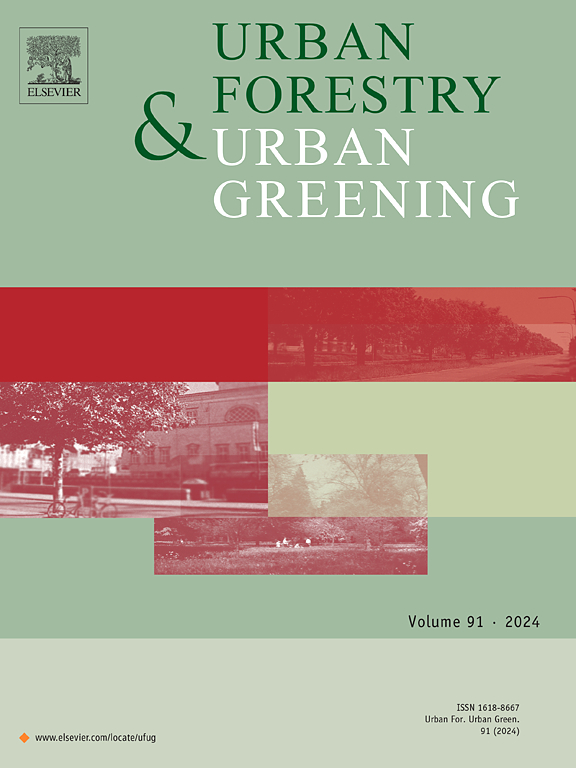3-30-300规则缓解城市洪水的效果如何?
IF 6
2区 环境科学与生态学
Q1 ENVIRONMENTAL STUDIES
引用次数: 0
摘要
3-30-300规则是一项新的城市林业和城市绿化指导方针,正迅速引起城市规划者、国际组织和非政府组织的兴趣。然而,这项新准则的生态系统服务效益尚未被量化,迄今为止还没有关于实施3-30-300规则如何缓解城市洪水的研究。在本研究中,我们使用包含流量衰减的理性方法的网格化实现(ANaRM模型)来评估通过实施城市土地利用变化来实现3-30-300目标的径流减少,这些目标在三个规模和人口对比明显的欧洲城市:丹麦奥胡斯市、克罗地亚格勒格勒卡戈里察市和法国巴黎地区。我们发现,新的绿地和树木覆盖的创建可以大大降低站点的峰值雨洪地表径流率,并在几平方公里的子集水区保持峰值流量减少几个百分点,包括在巴黎超过20 平方公里的一些子集水区减少超过10 %。满足3-30-300规则各方面要求的具体干预措施因研究区域而异,干预措施越大,可以实现的峰值径流率降低越大。本研究强调了将研究与政策联系起来的重要性,以便量化城市绿色基础设施目标的效益,并展示实施基于自然的解决方案的真正效益。本文章由计算机程序翻译,如有差异,请以英文原文为准。
How well does the 3–30–300 rule mitigate urban flooding?
The 3–30–300 rule is a new guideline for urban forestry and urban greening, which is rapidly gaining interest among city planners, international organizations and NGOs. However, the ecosystem service benefits of this new guideline have not been quantified and there has been no research to date on how implementing the 3–30–300 rule may mitigate urban flooding. In this study, we use a gridded implementation of the rational method, with flow attenuation included (ANaRM model), to assess the reduction in runoff that can be achieved by implementing urban land-use change to achieve 3–30–300 targets in three European cities of contrasting size and population: Aarhus Municipality (Denmark), Grad Velika Gorica (Croatia) and Paris Region (France). We find that the creation of new green spaces and tree cover can greatly reduce peak pluvial surface runoff rate at-site, and maintain peak flow reductions of several percent in sub-catchments of several square kilometres, including reductions of over 10 % in some sub-catchments of over 20 km2 in Paris. The specific interventions required to meet aspects of the 3–30–300 rule vary between study areas, and the larger the interventions, the greater the peak runoff rate reduction that can be achieved. This study highlights the importance of linking research with policy in order to quantify the benefits of urban green infrastructure targets and show the real benefits of implementing nature-based solutions.
求助全文
通过发布文献求助,成功后即可免费获取论文全文。
去求助
来源期刊

Urban Forestry & Urban Greening
FORESTRY-
CiteScore
11.70
自引率
12.50%
发文量
289
审稿时长
70 days
期刊介绍:
Urban Forestry and Urban Greening is a refereed, international journal aimed at presenting high-quality research with urban and peri-urban woody and non-woody vegetation and its use, planning, design, establishment and management as its main topics. Urban Forestry and Urban Greening concentrates on all tree-dominated (as joint together in the urban forest) as well as other green resources in and around urban areas, such as woodlands, public and private urban parks and gardens, urban nature areas, street tree and square plantations, botanical gardens and cemeteries.
The journal welcomes basic and applied research papers, as well as review papers and short communications. Contributions should focus on one or more of the following aspects:
-Form and functions of urban forests and other vegetation, including aspects of urban ecology.
-Policy-making, planning and design related to urban forests and other vegetation.
-Selection and establishment of tree resources and other vegetation for urban environments.
-Management of urban forests and other vegetation.
Original contributions of a high academic standard are invited from a wide range of disciplines and fields, including forestry, biology, horticulture, arboriculture, landscape ecology, pathology, soil science, hydrology, landscape architecture, landscape planning, urban planning and design, economics, sociology, environmental psychology, public health, and education.
 求助内容:
求助内容: 应助结果提醒方式:
应助结果提醒方式:


